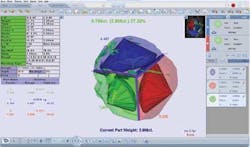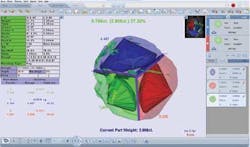3D IMAGING: 3D reconstruction software maps diamonds
To maximize the value of polished diamonds, any inclusions present in the rough diamond must be detected and mapped to assess the quality of the diamond. Once this is accomplished, the optimal method of cutting can be planned to maximize the value of the cut diamond or diamonds obtained from the rough stone.
To detect and map these inclusions, Sarine Technologies (Kfar Saba, Israel;www.sarine.com) has developed an automated computer tomography (CT) system to perform this task. Known as the Galaxy 1000, the system enables the internal features of a rough diamond to be visualized and allows an operator to locate inclusions of all types and sizes inside the diamond from the surface to the inside of the stone and display them as a 3D model. Based on this information, the system can then offer optimal cutting and polishing methods to maximize the value of the diamond based on correct weight, clarity and cut.
To accomplish this, the system first generates a 3D model of the external geometry of the stone. At this point, the internals of the diamond are still hidden. Then the system acquires an internal CT based image of the diamond and merges this data together with the external geometrical model into a 3D model of the diamond with all its inclusions.
To build this vision system to look inside the diamond, Sarine engaged RTC Vision (Kibbutz Givat Hashlosha, Israel;www.rtc-vision.com), which used their Pix3D software suite for 3D inspection and reconstruction to reconstruct a 3D image of the diamond based on the measured 2D projections. RTC further optimized this computationally-intensive task using graphical processors in the system's host PC.
"Due to the diamonds' unique physical characteristics, it's extremely challenging to automatically, accurately, and quickly detect, classify, and map inclusions regardless of their type, size, and location within the rough diamond. As conventional CT techniques are insufficient in these cases, we needed to use advanced technology that is capable of dealing with the limited data and complex mathematics" says Dr. Yossi Rubner, RTC Vision CEO and founder.
Once detected, these inclusions are then pseudo-colored according to their distance from the surface of the diamond – yellow on the surface, green close to the surface and red inside the diamond. Once this image is generated, planning software is used to determine which polished diamonds can be cut from the rough diamond.
Once the software has analyzed a multitude of possibilities, it identifies the most promising combinations and discerns how many and which polished diamonds need to be cut within the rough stone. In this way, profit is maximized by extracting the highest overall value of the polished stone or stones based on overall carat weight, clarity and cut. These results are then presented as graphical representations of the diamonds, their sizes, shapes and locations and which inclusions will be internal and which will be omitted from the final cut.
Data is also generated in tabular form showing the projected carat weight, clarity, cut grade and value of each diamond. Optimal laser sawing lines are also automatically depicted. Using the system, complex, heavily-included diamonds can be analyzed (see figure). In this example, a complex heavily-included rough diamond is analyzed. While traditional techniques can only focus on a single or possibly two polished stones, the system has analyzed, assessed and generated a complex cutting pattern that depicts how multiple diamonds can be cut.
www.vision-systems.comVision Systems Design May 2014
View other articles from our July 23D imaging e-newsletter.
Vision Systems Articles Archives

